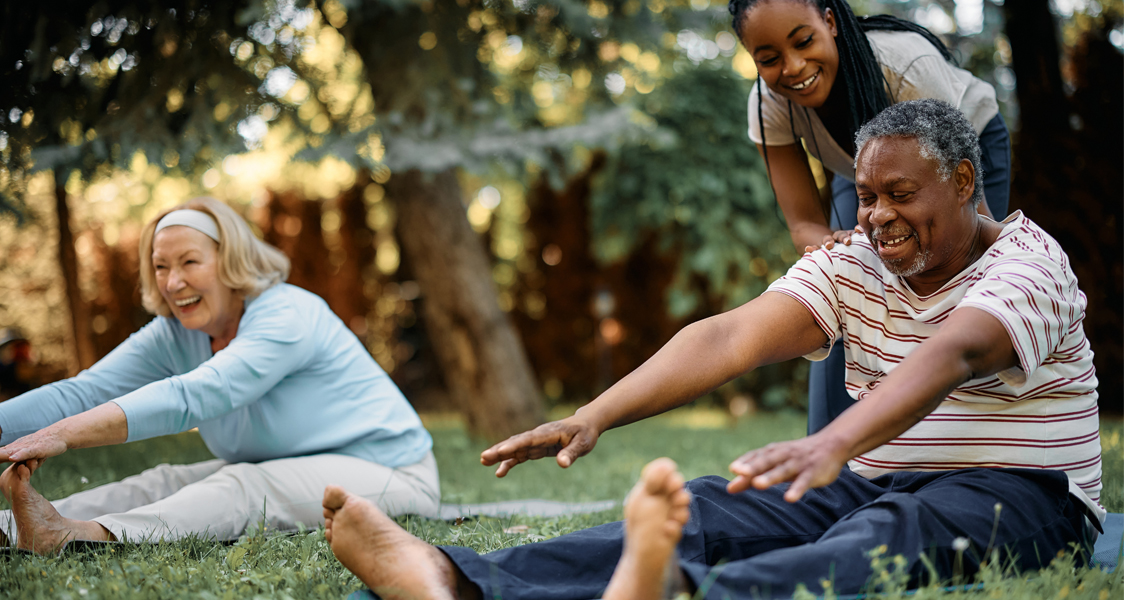Anyone who’s ever had sciatica knows how debilitating it can be. You may believe that crawling in bed and resting for a few days is the best treatment, but that can be counterproductive. One of the most effective ways to relieve your back and leg pain is physical therapy that includes gentle exercise, like stretching.
A physical therapist can guide you through exercises that will keep sciatica and lower back pain at bay. Movement may seem counterintuitive when you’re in excruciating pain but physical therapy is usually the best treatment for sciatica.
What is sciatica?
The sciatic nerve is the longest and widest single nerve in your body. It begins with five nerves in the lower back that join to form one nerve that branches through the pelvic bone. From there, it travels down the back of each buttock and thigh to the back of the knee, ending in the heel area of each leg. The sciatic nerve provides motor function to the abductor muscles in the hips, the muscles in the front of your lower leg and calf, and some muscles in your foot. [1]
When the sciatic nerve becomes inflamed and painful, it’s referred to as sciatica. Sciatica is a type of lower back pain, but not all lower back pain is sciatica. The cause of inflammation is usually pressure on the nerve from a bulging disc, overgrowth of bone, pregnancy, muscle spasms, degenerative diseases like spinal stenosis, or an injury. The inflamed nerve causes pain and sometimes numbness and tingling anywhere along its path. In severe cases, a person with sciatica can also experience leg weakness and bowel or bladder changes.
Symptoms of sciatica
Sciatica usually appears on only one side of the body, anywhere along the nerve’s path. Most commonly, pain is felt in the low back, buttock, back of the thigh or calf. The pain may appear as a mild ache, sharp or burning, or like a jolt or electric shock. Numbness, tingling or muscle weakness can accompany sciatica, including pain in one part of the leg and numbness in another.
What causes sciatica?
Pain occurs when the sciatic nerve becomes “pinched” or compressed at one point or multiple points. The nerve compression can be caused by:
- Bone spurs in the lumbar area of your spine
- A herniated or bulging disc
- A tumor
- Damage to the sciatic nerve from diabetes
- Age-related changes in the spine
- Stress on the spine due to obesity
- A job that requires twisting the back, carrying heavy loads, standing for long periods in awkward positions, physical stress on the spine or driving or sitting for long periods
- A sedentary lifestyle – inactive people are more likely to develop sciatica than active people
How physical therapy treats sciatica
With sciatica, resting can be counterproductive. Stretching and strengthening the nerves, muscles, and joints causing the pain, as well as education on posture and positioning, may help to decrease pressure on the nerve and thereby reduce pain. That’s why physical therapy can be of great benefit in relieving sciatica.
If you’re suffering from sciatica, Penn Medicine | Good Shepherd Rehabilitation Outpatient Therapy physical therapists will design a rehabilitation program to alleviate your pain. They’ll focus on strengthening your spine and core, as well as muscles in the lower back, abdomen, buttocks and hip to improve the flexibility of the muscles and nerves and restore pain-free movement.
“Patient participation is important. Physical therapists need to ensure that the patient understands what we are trying to address and how it can help.”
Michele Little, PT, DPT, Penn Medicine | Good Shepherd Rehabilitation Outpatient Therapy West Norriton/Trooper
Your sciatica rehabilitation program may include:
- Backward bending (extension) and forward bending (flexion) exercises to promote movement of the spine.
- Manual therapy techniques to reduce nerve compression
- Exercises to strengthen the abdomen, lower back, spine, hips or legs and supporting muscles or tendons. This may include isometric or isotonic exercises.
- “Nerve glides” (nerve stretching exercises) to increase movement and reduce symptoms
- Joint mobilization or manipulation
- Gait training to correct walking patterns that may contribute to sciatica
- Hands-on movement of the leg, hips and back to facilitate movement of the muscles and joints contributing to the pain.
- Posture and lifestyle modifications
- Home exercise program
- Massage
If you’re experiencing sciatica, make an appointment with Penn Medicine | Good Shepherd Rehabilitation Outpatient Therapy for an evaluation. Visit our back and spine pain treatment page or call 877-969-7342.
[1] Physiopedia, Sciatica

